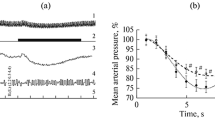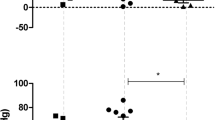Summary
Sympathetic action potentials from renal nerves were recorded in anaesthetized cats during stimulation of the hypothalamus and medulla oblongata. Blood pressure and blood flow through the hind limbs were measured continuously; in the same cats the isolated hind limb was perfused from a donor cat. Stimulation of the hypothalamic defence area caused an increase of sympathetic activity for 3 sec; after this an inhibition of a few seconds duration was observed. The onset of this inhibition was followed by the typical increase of muscle blood flow. This increase was abolished after treatment with atropin (5 mg/kg). The duration of inhibition depended on the slope and magnitude of blood pressure increase and correlated well with the decrease of flow resistance in the muscle vessels. With reappearance of sympathic activity the flow increase was diminishing. The inhibition of sympathetic action potentials did not last long enough to explain the magnitude of the increase in blood flow. Stimulation outside the defence area caused no inhibition of sympathetic activity. The vasodilatation usually occurred with a latency of about 5 sec, whereas the latency for vasoconstriction amounted to 2 seconds only.
It is concluded that the vasodilatation observed is not due to an inhibition of sympathetic activity, though vasodilatation occurred to the greatest extent during the inhibitory interval.
Zusammenfassung
An narkotisierten Katzen wurden während einer elektrischen Reizung in der “defence area” des Hypothalamus sowie in pressorischen Gebieten des Hypothalamus und der Medulla oblongata die sympathischen Aktionspotentiale eines Nierennervs, der Blutfluß durch die Hinterextremitäten und der Blutdruck kontinuierlich gemessen. Die Versuche wurden zum Teil an jeweils zwei Katzen mit gekreuztem Kreislauf durchgeführt. Bei der Reizung in der “defence area” stieg die Frequenz der sympathischen Aktionspotentiale zunächst an, sie wurden aber etwa 3 sec nach Reizbeginn für einige Sekunden gehemmt. Während dieser Hemmung entwickelte sich die für eine Reizung in der “defence area” typische Durchblutungszunahme in den Muskelgefäßen. Die Dauer der Hemmung veränderte sich mit der Stärke des Blutdruckanstiegs und korrelierte mit der Widerstandsabnahme in den Hinterextremitäten. Die Hemmung kann allein nicht die Ursache der Vasodilatation sein, aber die Dilatation entwickelt sich in dieser Periode. Mit dem Wiedereinsetzen der sympathischen Aktionspotentiale wurde die Blutflußzunahme in den Hinterextremitäten verzögert. Reize in anderen Gebieten des Hypothalamus, also nicht in der “defence area”, die zu einer vasokonstriktion führten, verursachten keine Hemmung der sympathischen Aktionspotentiale während der Reizung. Die Dilatation setzte mit einer Latenz von etwa 5 sec nach Beizbeginn ein, während die Latenz für eine Vasokonstriktion nur 2 sec betrug.
Similar content being viewed by others
Literatur
Abrahams, V. C., S. M. Hilton andA. Zbrozyma, Active muscle vasodilation produced by stimulation of brain stem: its significance in the defence reaction. J. Physiol. (Lond.)154, 491–513 (1960).
Bolme, P., S. H. Ngai andS. Rosell, Influence of Vasoconstrictor Nerve Activity on the Cholinergic Vasodilator Response in Skeletal Muscle in the Dog. Acta physiol. Scand.71, 323–333 (1967).
Djojosugito, A. M., B. Folkow, P. H. Kylstra, B. Lisander andR. S. Tuttle, Differentiated Interaction between the Hypothalamic Defence Reaction and Baroreceptor Reflexes. Acta physiol. Scand.78, 376–385 (1970).
Eliasson, S., P. Lindgren andB. Uvnäs, Representation in the hypothalamus and the motor cortex in the dog of the sympathetic vasodilator outflow to the skeletal muscles. Acta physiol. Scand.27, 18–37 (1952).
Folkow, B. andB. E. Gernand, An Electrophysiological Study of the Sympathetic Vasodilator Fibers of the Limb. Amer. J. Physiol.169, 622–628 (1952).
Folkow, B., B. Johansson andB. Öberg, A Hypothalamic Structure with a marked Inhibitory Effect on Tonic Sympathetic Activity. Acta physiol. Scand.147, 262–270 (1959).
Folkow, B., B. Lisander, R. S. Tuttle andS. C. Wang, Changes in Cardiac Output upon Stimulation of the Hypothalamic Defence Area and the Medullary Depressor Area in the Cat. Acta physiol. Scand.72, 220–233 (1968).
Folkow, B., B. Öberg andE. H. Rubinstein, A Proposed Differentiated Neuro-Effector Organization in Muscle Resistance Vessels. Angiologica1, 197–208 (1964).
Folkow, B. andE. H. Rubinstein, Cardiovascular Effects of Acute and Chronic Stimulation of the Hypothalamic Defence Area in the Rat. Acta physiol Scand.68, 48 (1966).
Horeyseck, G., W. Jänig, F. Kirchner andV. Thämer, Activation of muscle vasodilator neurons by hypothalamic stimulation. Brain Research48, 394 (1972).
Kylstra, P. H. andB. Lisander, Differentiated Interaction between the Hypothalamic Defence Area and Baroreceptor Reflexes. Acta physiol. Scand.78, 386–392 (1970).
Lindgren, P., The mesencephalon and the vasomotor system. Acta physiol. Scand.35, Suppl. 121, 1–189 (1955).
Lindgren, P. andB. Uvnäs, Activation of sympathetic vasodilator and vasoconstrictor neurons by electric stimulation in the medulla of the dog and cat. Circulat. Res.1, 479–485 (1953).
Lisander, B., Factors influencing the autonomic component of the defence reaction. Acta physiol. Scand.80, Suppl. 351 (1970).
Uvnäs, B., Sympathetic vasodilator system and blood flow. Physiol. Rev.40, Suppl. 4, 69–76 (1960 b).
Author information
Authors and Affiliations
Additional information
Mit 5 Abbildungen und 1 Tabelle
Rights and permissions
About this article
Cite this article
Thämer, V., Kirchner, F. & Stock, G. Muskeldurchblutung und sympathische Aktionspotentiale während einer Vasodilatation durch zentrale Reizung. Basic Res Cardiol 69, 320–330 (1974). https://doi.org/10.1007/BF01906211
Received:
Issue Date:
DOI: https://doi.org/10.1007/BF01906211




